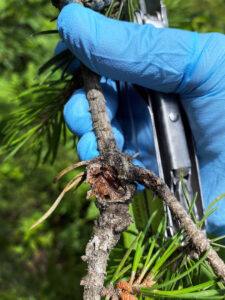
Hollow pitch blisters get darker with age and may resemble cones until closer examination. / Photo Credit: Wisconsin DNR
By Linda Williams, DNR Forest Health specialist, Woodruff
Linda.Williams@wisconsin.gov or 920-360-0665
Northern pitch twig moth (Petrova alhicapitana) is also called the pitch nodule maker or pitch blister moth.
It feeds on branches and twigs of young jack pine and scotch pine, causing a hollow blister of gooey pitch to form around the larvae as it feeds at the base of a lateral branch. It prefers trees that are 20 feet tall or smaller, although it can attack older trees.
The larva is a pink- or reddish-colored caterpillar that takes two years to complete development. Caterpillars feed at a branch union, which causes a pitch blister to form each year, but the first-year pitch bubble is smaller than the second year. The damage caused by the feeding caterpillar may damage the branch enough to kill the branch tip or allow lateral branches to break off. The adult is a small reddish-brown colored moth that does no damage.

Opening the pitch blister caused by northern pitch twig moth on a pine twig, with hollow space underneath. In this photo, a pupal case rests inside after its larvae completed development. / Photo Credit: Wisconsin DNR
Control is generally not practical because the larvae are protected inside the pitch blister. By scraping away the pitch blister, the larvae inside can be squashed. Corrective pruning can be done if damage is extensive or occurs on the terminal leader — but, then again, it attacks jack pine or Scotch pine, and they don’t typically have perfect form anyway.
